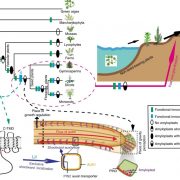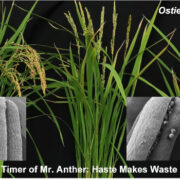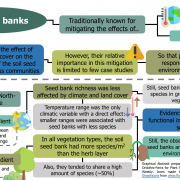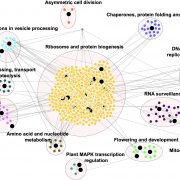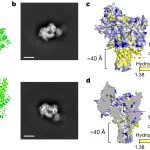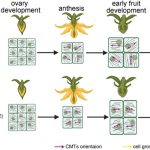Oryza glumaepatula: A wild relative to improve drought tolerance in cultivated rice
 When we speak about rice, we’re often referring to one of two domesticated species, Oryza japonica or Oryza indica. However, there are an additional 25 species in the genus Oryza. These so-called wild relatives harbor substantial genetic diversity that holds promise for crop improvement. Here, Prakash et al. surveyed 22 Oryza species for drought tolerance traits. This study is impressively robust. The authors looked at phenotypes of plants grown in greenhouse cylinders and screenhouse paddies in both well-watered and drought-stress conditions, and measured a wide range of growth and physiological outcomes. Their initial screens pointed to O. glumaepatula as showing improved drought tolerance, so they next screened a panel of 69 accessions (obtained from the International Rice Research Institute, IRRI, and the National Institute of Genetics, Japan). The O. glumaepatula panel was subject to genome sequencing analysis and genome-wide association studies to identify regions associated with “least reduction in shoot biomass” and “lower stomatal density” under drought. Interestingly, the drought-tolerant accessions originate from flood-prone regions in the Amazon River Basin, supporting a previous connection between flooding tolerance and drought tolerance, possibly arising from heightened ethylene sensitivity. This impressive effort opens many interesting lines of inquiry. (Summary by Mary Williams @PlantTeaching) Plant Physiol. 10.1093/plphys/kiad485
When we speak about rice, we’re often referring to one of two domesticated species, Oryza japonica or Oryza indica. However, there are an additional 25 species in the genus Oryza. These so-called wild relatives harbor substantial genetic diversity that holds promise for crop improvement. Here, Prakash et al. surveyed 22 Oryza species for drought tolerance traits. This study is impressively robust. The authors looked at phenotypes of plants grown in greenhouse cylinders and screenhouse paddies in both well-watered and drought-stress conditions, and measured a wide range of growth and physiological outcomes. Their initial screens pointed to O. glumaepatula as showing improved drought tolerance, so they next screened a panel of 69 accessions (obtained from the International Rice Research Institute, IRRI, and the National Institute of Genetics, Japan). The O. glumaepatula panel was subject to genome sequencing analysis and genome-wide association studies to identify regions associated with “least reduction in shoot biomass” and “lower stomatal density” under drought. Interestingly, the drought-tolerant accessions originate from flood-prone regions in the Amazon River Basin, supporting a previous connection between flooding tolerance and drought tolerance, possibly arising from heightened ethylene sensitivity. This impressive effort opens many interesting lines of inquiry. (Summary by Mary Williams @PlantTeaching) Plant Physiol. 10.1093/plphys/kiad485


